Commentary
During one of my down-the-rabbit-hole adventures on the web, I coincidentally ran across an announcement for the
UNCF Career Pathways Initiative conference focused on “purposeful approaches to leveraging disruptions in higher education." Although this conference is limited to participating institutions and invited participants, it is the description of the content and theme that really captured my attention as important for any institution. The Data Institute, a special track within the larger conference, features sessions aimed at helping institutions “gain 1) a better understanding of how to effectively use data technology on their respective campuses; 2) knowledge on how to best execute data analysis projects and produce useful reports; and 3) tools to develop necessary relationships to facilitate cross-campus data sharing and communication.” I spoke with Ed Smith-Lewis, the Director of the Career Pathways Initiative (CPI) and Samaad Wes Keys the CPI Program Strategist to gain some insight on how this particular theme came to be a conference for the organization. This conference is part of a multi-year grant funded by the
Lilly Endowment, Inc. aimed at helping participating institutions develop intentional guided pathways, make curricular enhancements and convert typically “extra-curricular” experiences (internships, study abroad, etc.) into co-curricular activities for all students. The convening was created to focus on how lower resources institutions are taking disruptions and imbedding it into their institutions and making those disruptions work for them. The intent is share what innovative institutions are already doing well, and for other institutions to collaborate, adopt and adapt those practices to become innovative institutions themselves. This year’s convening will also take a different approach than in the past for the 90-minute concurrent sessions. The first 25 minutes will be dedicated to the presenters sharing their practices and the remainder to the participants and facilitators discussing how the practice can be adopted and adapted to their various campuses.
AACRAO Research Update
New Research Advisory Board Member
The AACRAO RAB is pleased to announce that we have a new member, Michael Flanigan, starting with the RAB on July 1st. Dr. Veronica Garcia is stepping away from her role on the RAB. She has been a valuable member of the group, and her service is greatly appreciated.

Michael S. Flanigan (Mike) is the Director of Planning and Operational Technologies in the Division of Strategic Enrollment Management at Virginia Commonwealth University. His leadership experience includes higher education roles in organizational change, information technology, admissions, registration, financial aid, ERP implementation, and one-stop student services center development, as well as private industry experiences as a technology director and project manager. He received his Doctorate of Education in Leadership from Virginia Commonwealth University and his Master of Science in Computer Information Systems from Arizona State University. His areas of research interest include organizational culture and effectiveness, the future of higher education, and the application of advanced technologies to the enrollment management and student success fields.
Project Updates
We are chugging along on the project examining the factors contributing to excess credits at graduation, and we have just developed an agreement to work on another joint project focusing on college and university marketing efforts to attract high school seniors.
The July 60-Second survey will examine the use of alternative credentials beyond the diploma and transcript. This survey will be distributed the week of July 9th rather than the first week of the month due to the July 4th holiday. The September survey is tentatively scheduled to be an update of the 2015 admissions practice
snapshot. If there is something you’d really like to know about admissions practices that was not included in the 2015 survey, please
email me with your ideas.
Current Higher Education Research and Related Topics
Invitation to Provide Feedback to IPEDS on Reporting Dual Enrollment
A couple of months ago, I participated in an IPEDS Technical Review Panel. The purpose of this panel was to provide feedback on how best to capture and clarify dual enrollment data. Although the second day of the event got canceled due to the winter storm in D.C. in late spring, the first day was full of lively discussion on the topic amongst the group assembled. The team responsible for leading these review panels has opened the summary of the comments for feedback. Capturing dual enrollment information correctly and consistently is an important topic for many institutions. If you have an interest in the topic, please use the link above to review the summary and submit comments by July 5th.
Grants Opportunity: Strada Education Network
Strada Education Network (Strada) is
inviting proposals for multi-year grants that strengthen the education-to-employment pathway.The grant pool is worth $5 million, and Strada intends to fund five to seven organizations. They are seeking proposals that include at least three of four partners: employers,community-based organizations, education providers, and the public sector.
Southern Utah University Increases First-Year Retention by 7%
The Chronicle of Higher Education
reported on efforts at Southern Utah University to increase first-year retention over the course of three years. The university built a first-year experience that “combined financial support with enhanced advising, earlier identification of struggling students, and a focus on fostering a sense of belonging.” They also revised orientation and the first-year seminar as well as created a peer-mentoring program. There was a 7% improvement in first-year retention from 2015, and the institution is on track to reach a 10% increase and a first-year retention rate of 74%. The author notes that institutions are in a position where they must pay more attention to retention, and a range of approaches are being undertaken to do so.
National Veteran Education Success Tracker (NVEST)
The National Veteran Education Success Tracker (NVEST) is the “first comprehensive, in-depth study of the academic success of the contemporary student veteran using the Post-9-11 GI Bill.” Their first round of research has been released in a
fact-sheet comprised of a series of infographics. The image below is summary of the demographics of these students from the factsheet. The remainder of the fact-sheet contains data on degree fields and academic outcomes. Students who have used the Post 9/11 veteran’s benefits have a reported success rate of 72%, and most attend public institution. The largest numbers of degrees awarded were in business management and marketing.
Last-Dollar Financial Aid and First-Year Outcomes
The Community Development and Regional Outreach arm of the Federal Reserve Bank of Philadelphia collaborated with Rutgers-Camden to examine the impact of last-dollar program using a mixed methods approach. Last-dollar programs are financial aid programs that supplement existing sources of need-based aid.
The authors’ key findings include:
- The program substantially boosted the likelihood of enrollment for income-eligible students
- Diminished financial stress for students and the ability to work less
- Some still struggled to balance work and class and expenses
- Middle-income-program-eligible students were more like to meet academic requirements than lower-income students
Stats in Brief NCES Report: Trends in Subbaccalaureate Occupational Awards 2003-2015
The National Center for Educational Statistics released a new brief highlighting occupational awards trends. The figure below from the brief highlights the trends. Subbaccalaureate occupational credentials accounted for 38% of all undergraduate credentials in 2015 and public institutions are the predominant provider. Health sciences, the trades, consumer services and business management represent 75% of the awards.
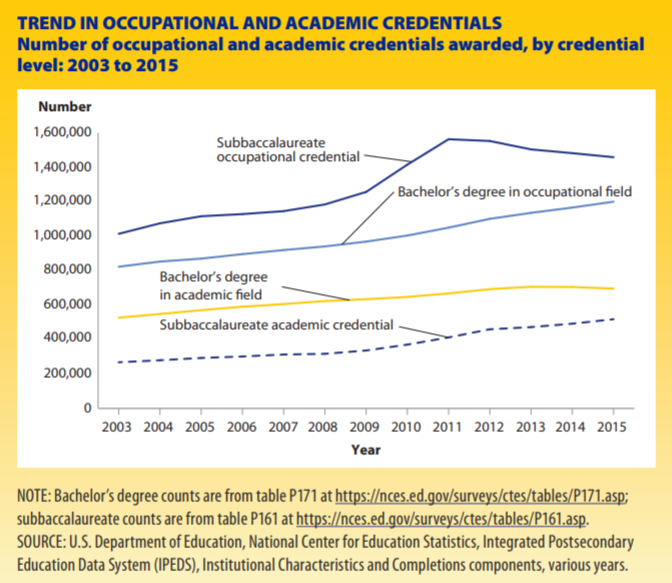
Completion Reforms that Work
The Thirdway authors reviewed five reforms that appear to work and synthesize key factors associated with successful programs. Highlights of the review include:
- No “Plug and Play” Solution
- Programs only effective while active
- Wraparound support most successful
- Programs ultimately resulted in lower costs for students, colleges and taxpayers
National and State Trends for Latino Student Degree Attainment
Authors at the Education Trust used U.S. Census data to analyze the degree attainment level for Latino students. The figure below from their report summarizes the national level data from the 2016 American Community Survey. The difference between Latino and White adult college degree attainment is 24.5% (22.6% vs. 47.1% respectively). At the bachelor’s level the difference between Latino and White adults is 12.7%, 8.4% at the master’s level, compared to 3.4% at the associate’s level.
Degree Attainment for Latino and White Adults in the U.S., 2016
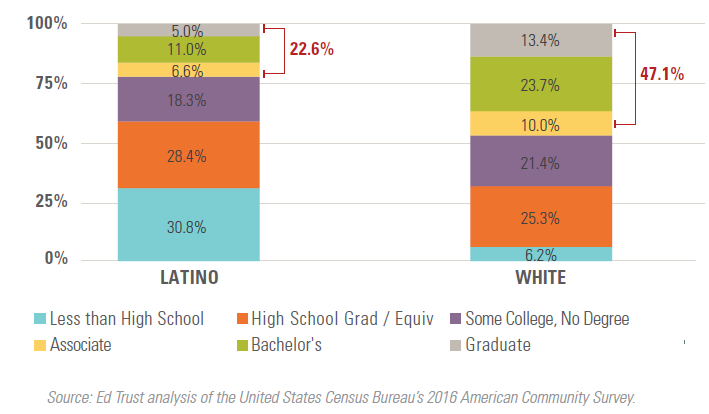
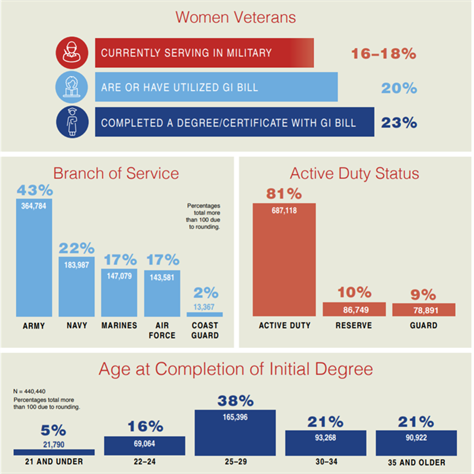
Source: http://nvest.studentveterans.org/wp-content/uploads/2017/02/NVEST_Factsheets.pdf
Disparities by Race among College Completers
The Center for American Progress analyzed IPEDS data on black, Hispanic, and white students from 2013-2015 and created a comprehensive report on the disparities between the races in institution type, spending on students, resources, selectivity, type of degree earned, and other measures. Among the findings, black and Hispanic students were found to complete at a higher rate at for-profit institutions than white students (figure 1 from report below). Black and Hispanic students were also found to earn their degrees from institutions that spend less per student than those who graduate more white students. The author also uses the selectivity and resource index (SRI), which measures institutions’ selectivity and resources. This SRI analysis indicated that the “median institution for white students ranks about 600 places higher than the median institution for black students” and 200 places higher for Hispanic students.
The author makes recommendations on how to address these disparities, such as: 1) “include race equity measure in federal accountability structures,” 2) “create a student-level data system to track outcomes by race,” 3) use state data to address issues, and 4) learn from institutions that are doing well.
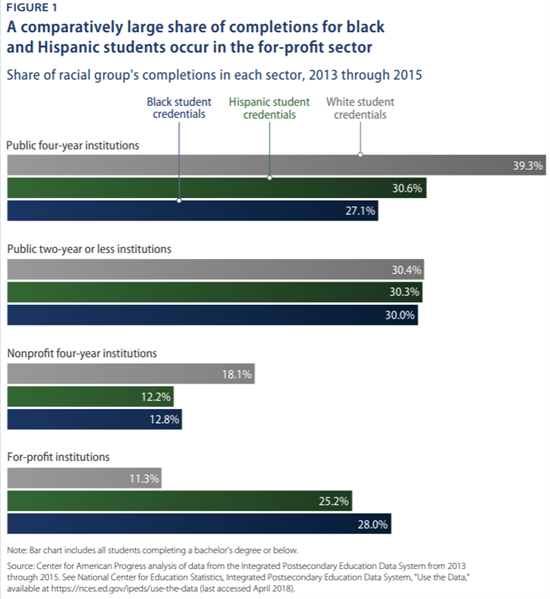
Figure 4 from the report also highlights the disparity between the type of degrees earned.
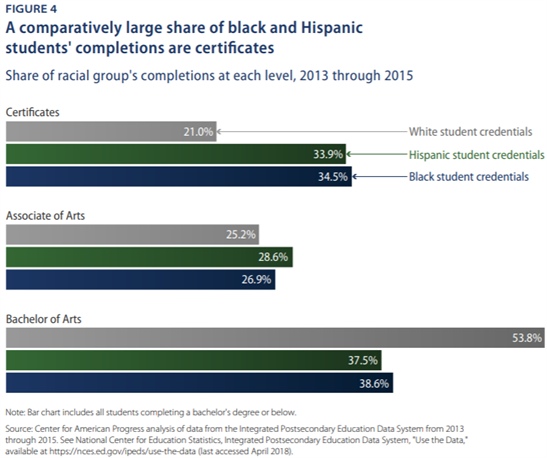
Perspectives from Adults without Degrees about Going Back to College
Public Agenda is a nonpartisan, nonprofit organization based in NYC. Public Agenda, in partnership with the Kresge Foundation, surveyed more than 1,300 18-55 year-old high school graduates who are seeking to enroll in a degree or certificate program in the next two years including those with low-incomes. The aim of the research was to gain an understanding of motivations, expectations, strategies, and concerns about enrolling in college. The key findings include:
- Primary motivation is to improve career prospects, specifically a different kind of job or career
- More think a bachelor’s degree is a wiser investment than an associate’s degree
- Debt and balancing studies and work are top concerns
- They view requiring institutions to provide financial counseling as a very good idea
- Most plan to either transfer and/or attend part time
- Most are seeking online options but believe that students get more out of in-person courses
- Most think colleges and faculty can help them make decisions about which college to attend
Calling Campaign Translates into Nine Fold Return in Investment
Campus Technology reported on a calling campaign at Mesa Community College that reversed an enrollment decline. The college contracted with an outside agency to make calls to students who had not yet completed the application and to students who had not enrolled in a couple of semesters. The college completed three calling campaigns for fall 2016, spring 2017, and summer 2017. As a result of these campaigns, an additional 7,584 students enrolled (a $969,932 increase in revenue) and persistence rates increased by 12 percent. Some of the students were not reachable by phone but still enrolled. Mesa Community College is using that percentage of students as a baseline of those who would have enrolled anyway.